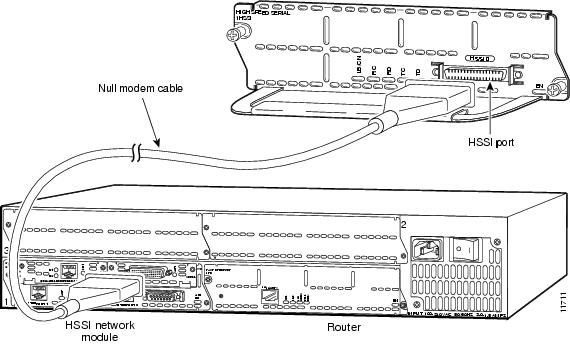High-Speed Serial Interface Network Modules
Available Languages
Table Of Contents
Connecting Cisco HSSI Network Modules to the Network
Connecting HSSI Modules to the Network
Obtaining Documentation, Obtaining Support, and Security Guidelines
Connecting Cisco HSSI Network Modules to the Network
Revised: May 1, 2008, OL-12817-01
This guide describes how to connect Cisco High-Speed Serial Interface (HSSI) network modules to your network. It contains the following sections:
•
Connecting HSSI Modules to the Network
•
Obtaining Documentation, Obtaining Support, and Security Guidelines
HSSI Network Modules
The 1-port High-Speed Serial Interface (HSSI) network module (see Figure 1) provides connectivity for fractional DS3 rate links and slower.
Figure 1 HSSI Network Module

Connecting HSSI Modules to the Network
The HSSI module contains a 50-pin receptacle, color-coded blue. You can connect this port to a network in either of two ways:
•
To an external data service unit (DSU), using a HSSI data terminal equipment (DTE) cable for operation in DTE mode (see Figure 2). The HSSI port is configured to operate in this mode by default.
•
To another router for back-to-back operation, using a HSSI null modem cable. (See Figure 3.) Both routers must be at the same site. Back-to-back operation allows you to verify operation of the HSSI port or link routers directly to build a larger node. Both routers must be configured to use a 51.84-MHz internal clock.
Figure 2 Connecting the 1-Port HSSI Module to an External DSU

Figure 3 Connecting Two Routers Back to Back

HSSI Network Module LEDs
All network modules have an enable (EN) LED. The enable LED indicates that the module has passed its self-tests and is available to the router. The HSSI network module has the additional LEDs shown in Figure 4 and described in Table 1.
Figure 4 HSSI Network Module LEDs

Related Documents
For additional information, see the following documents and resources.
Regulatory compliance and safety information
Cisco Network Modules and Interface Cards Regulatory Compliance and Safety Information
http://www.cisco.com/en/US/docs/routers/access/interfaces/rcsi/IOHrcsi.htmlCisco IOS software website and reference documentation
Cisco IOS Software http://www.cisco.com/web/psa/products/index.html?c=268438303
Obtaining Documentation, Obtaining Support, and Security Guidelines
For information on obtaining documentation, obtaining support, providing documentation feedback, security guidelines, and also recommended aliases and general Cisco documents, see the monthly What's New in Cisco Product Documentation, which also lists all new and revised Cisco technical documentation, at:
http://www.cisco.com/en/US/docs/general/whatsnew/whatsnew.html
CCDE, CCENT, Cisco Eos, Cisco Lumin, Cisco StadiumVision, the Cisco logo, DCE, and Welcome to the Human Network are trademarks; Changing the Way We Work, Live, Play, and Learn is a service mark; and Access Registrar, Aironet, AsyncOS, Bringing the Meeting To You, Catalyst, CCDA, CCDP, CCIE, CCIP, CCNA, CCNP, CCSP, CCVP, Cisco, the Cisco Certified Internetwork Expert logo, Cisco IOS, Cisco Press, Cisco Systems, Cisco Systems Capital, the Cisco Systems logo, Cisco Unity, Collaboration Without Limitation, EtherFast, EtherSwitch, Event Center, Fast Step, Follow Me Browsing, FormShare, GigaDrive, HomeLink, Internet Quotient, IOS, iPhone, iQ Expertise, the iQ logo, iQ Net Readiness Scorecard, iQuick Study, IronPort, the IronPort logo, LightStream, Linksys, MediaTone, MeetingPlace, MGX, Networkers, Networking Academy, Network Registrar, PCNow, PIX, PowerPanels, ProConnect, ScriptShare, SenderBase, SMARTnet, Spectrum Expert, StackWise, The Fastest Way to Increase Your Internet Quotient, TransPath, WebEx, and the WebEx logo are registered trademarks of Cisco Systems, Inc. and/or its affiliates in the United States and certain other countries.
All other trademarks mentioned in this document or Website are the property of their respective owners. The use of the word partner does not imply a partnership relationship between Cisco and any other company. (0804R)
Any Internet Protocol (IP) addresses used in this document are not intended to be actual addresses. Any examples, command display output, and figures included in the document are shown for illustrative purposes only. Any use of actual IP addresses in illustrative content is unintentional and coincidental.
© 2008 Cisco Systems, Inc. All rights reserved.
Contact Cisco
- Open a Support Case

- (Requires a Cisco Service Contract)
 Feedback
Feedback